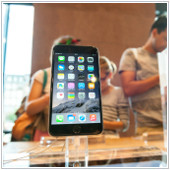 Even if you’re a longtime Apple user, you might still have a hard time deciding which iPhone is right for you. The number of available models continues to grow and most stores are currently offering at least five different versions. If you’ve been holding off buying one until now, you need to weigh the various features before deciding which one is right for you, let’s take a look at what makes them all different.
Even if you’re a longtime Apple user, you might still have a hard time deciding which iPhone is right for you. The number of available models continues to grow and most stores are currently offering at least five different versions. If you’ve been holding off buying one until now, you need to weigh the various features before deciding which one is right for you, let’s take a look at what makes them all different.
The iPhones currently adorning display tables in any Apple store are the 6s Plus, 6s, 6 Plus, 6 and SE. Although the models with the letter ‘S’ in their names are the newest releases and boast slightly faster CPU and RAM speeds, the average user will have a hard time pushing the iPhone 6 and 6 Plus to their max. There are, however, a number of other design features that can prove important when choosing the right iPhone model for your needs.
Display
One of the things that gets the most attention when highlighting any smartphone’s features is screen size. Across the five devices there are three different screen sizes: 4 inch, 4.7 inch and 5.5 inch. The tradeoffs of screen size are pretty self-explanatory and definitely based on personal preference. The ‘Plus’ models feature a 5.5-inch, 401-ppi screen so your games and videos will be far more engaging and detailed than the iPhone SE’s 4-inch, 326-ppi screen; but holding an iPhone 6 Plus/6s Plus in one hand or carrying it in your pocket will become a luxury of the past.
Beyond preference in size and resolution, iOS has different keyboards for different screen sizes, including cut, copy and paste keys in the extra space afforded to the larger screens.
Storage
Another hotly debated topic among the various iPhone supporters is storage capacity. Ranging from 16gb to 128gb, picking the right storage is becoming increasingly important as apps become denser and cameras take higher quality photos. 16gb may sound like plenty, but after the core OS is installed you’re left with 11.5gb of space — or 1,900 photos if you don’t install any apps or download any music. On the other hand, 128gb becomes 114gb after iOS is added and still has room for 20,000 pictures.
Battery
If you’re using your iPhone primarily for work-related tasks, screen size and storage capacity may not be your biggest concerns. Between cross country business trips and sending after hours emails, battery life is the biggest obstacle to getting the most of your mobile device. When it comes to voice calls, the ‘Plus’ models take the cake with 24 hours of battery life. However, when it comes to power consumption while using data the budget SE iPhone stands toe-to-toe with all of the models boasting 12 hours of continuous use. The ‘Plus’ models are slightly better when watching video and listening to audio, but the difference is negligible and battery life shouldn’t ultimately dissuade anyone from buying the SE unless they plan to spend above average amounts of time making audio calls.
Camera
Although other smartphone manufacturers can offer up a fair amount of competitiveness in the camera department, Apple has worked hard to make iPhones synonymous with serious photography. The most recent models, the 6s Plus, 6s and SE, made a pretty big splash with their most recent hardware upgrade. Offering up the chance at 12 megapixel (mp) photos and 4k resolution video from a phone helps to narrow down which model is for you if the camera is your biggest priority. The 6 Plus and 6 allow for 8mp photos and 1080p video.
While the flagship 6s Plus and 6s do have a number of hardware and software features that set them apart from the SE, the biggest takeaway is that Apple’s cheapest iPhone camera will actually beat out their mid-range models.
Price
There is a significant difference in price between the current models, which will make this one of the most important decisions regardless of your other priorities. The iPhone 6s Plus is a pricey $749 without contract signing bonuses. Even if you do want a top of the line model, that’s hard to argue when the SE is almost half of that at $399. The 6 Plus and the 6 are $649 and 549$ respectively, making them the best options for consumers in the market of a mid-range iPhone.
All of these considerations are complicated by the fact that a new iPhone model is expected in September. If you can manage to wait until then all of the phones we’ve covered here will most likely be discounted. If not, it might be worth it to choose a model one step higher in preparation for iOS updates and features that give preference to the newer, faster phones.
Whether you’re purchasing an iPhone on a two-year contract or not, it’s generally a long term commitment. If you’re still unsure which model is right for you, or you want help making the switch to your upgrade, call us on your old phone so we can smooth the transition to your brand new iPhone.